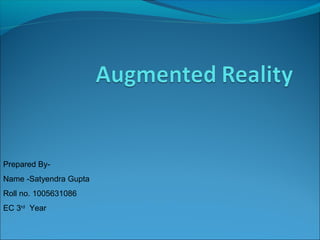
Augmented reality
- 1. Prepared ByName -Satyendra Gupta Roll no. 1005631086 EC 3rd Year
- 2. Contents Introduction Augmented reality system Example – Wikitude, Google glass, AugmenteDev Components of AR system Head mounted display Augmented Reality Vs Virtual reality Applications fields Limitations Conclusion references
- 3. Introduction Augmented Reality is a field of computer research which deals with combination of reality with computer generated data. With augmented-reality displays, which will eventually look much like a normal pair of glasses, informative graphics will appear in your field of view, and audio will coincide with whatever you see. These enhancements will be refreshed continually to reflect the movements of your head.
- 4. Augmented Reality System An augmented reality system is one that Combine real n virtual world Is interactive in real time Is registered in 3D.
- 5. Mobile application based on Augmented Reality … Wikitude - WIKITUDE World Browser presents the user with data about their surroundings, nearby landmarks, and other points of interest by overlaying information on the real-time camera view of a smart-phone. Augmentedev- It is basically superimposes the 3D graphics on real world by placing a marker in front of smart device’s camera.
- 6. Components Here are the some components needed to make an augmented-reality system work: display tracking system eg- Gps,Digital compass mobile computing power
- 7. Head-mounted Displays Just as monitors allow us to see text and graphics generated by computers, head-mounted displays (HMDs) will enable us to view graphics and text created by augmented-reality systems There are two basic types of HMDS: video see-through optical see-through
- 8. Video See Through Displays They block out the wearer's surrounding environment, using small video cameras attached to the outside of the goggles to capture images. On the inside of the display, the video image is played in real-time and the graphics are superimposed on the video. One problem with the use of video cameras is that there is more lag, meaning that there is a delay in image-adjustment when the viewer moves his or her head.
- 9. Optical See Through Display It is supposed to consist of ordinary looking pair of glasses that will have light source on the side to project images onto the retina. Eg- Google glass
- 10. Augmented VS Virtual Reality Virtual reality creates immersive, computer generated environments which replaces real world. Augmented reality is closer to the real world. augmented reality add graphics, sounds & smell to the natural world, as it exists.
- 11. Applications fields of AR Once researchers overcome the challenges that face them, augmented reality will likely pervade every corner of our lives. It has the potential to be used in almost every industry, including: Education Military Instant information Gaming
- 12. Limitations Accurate tracking and orientation For wearable augmented reality system, there are still enough computing power to create stereo 3D graphics The size of AR systems is yet another problem.
- 13. Conclusion Augmented reality will further blur the line between what's real and what's computer-generated by enhancing what we see, hear, feel and smell.
